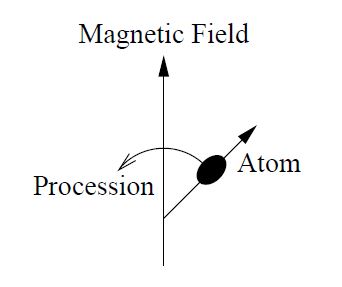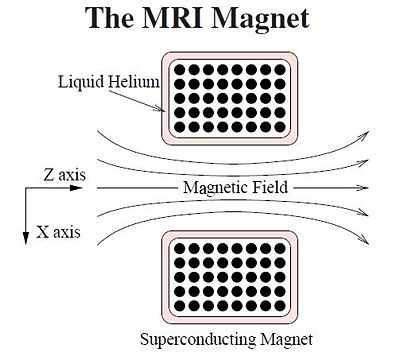Magnetic Resonance Imaging (MRI)
A slecture by ECE student Sahil Sanghani
Partly based on the ECE 637 material of Professor Bouman.
Contents
Introduction
Magnetic Resonance Imaging (MRI) is a different mode of imaging from the previously discussed ones. It is characterized by using changing magnetic fields and RF waves to selectively resonate areas of interest for imaging. MRI does not use ionizing radiation like CT does, and it is very flexible and adaptable. It can be reprogrammed to fit specific needs. It is also very high in resolution with normal scans having a resolution on the order of millimeters. Theoretically the only bound on the resolution is the length of the scan. This quality has its trade-offs. MRI is very expensive and the length of the scan is long. A big superconducting magnet, which is very expensive, is needed. Despite these drawbacks, MRI has many different uses. It can be used for conventional anatomical scans, as a functional imaging modality (oxygen activity levels in the brain), and as other modalities.
Magnetic Resonance
Atoms that have a magnetic dipole process around the magnetic field's axis, not unlike how a top takes a wider rotation as slows down. Figure 2 shows how these atoms process.
Different atoms have different procession frequencies, which is called the Lamor Frequency, based on intrinsic qualities and the surrounding magnetic field. Hydrogen is the typical atom of focus in conventional MRI scanners due to its ubiquity in the water contained in the soft tissue of the body. At a magnetic field strength of 1.5T, the Lamor frequency for H is 63 MHz.
Let
$ M: $= magnitude of the magnetic field
$ \omega_0: $= the frequency of procession (Lamor frequency)
$ L: $= Lamor constant, which is an intrinsic atomic quality
The Lamor frequency is defined as
$ \omega_0 = LM \ $
The procession can resonate with an RF signal targeted at the atom if the RF signal is at the center frequency of procession. Once the RF signal is removed, the atom will radiate RF energy until the energy is lost. The sensitivity of procession to magnetic field is used to selectively choose slices for analysis, and the RF energy emission is used to create pinpoint specific nuclei of interest. This data makes up the projections used in reconstruction.
MRI Hardware
Clinically high strength magnetic fields are used for imaging because ensure good resolution. Also, the radius of the bore where the patient enters the scanner is relatively large, so stronger fields are needed to compensate. In order to generate these large magnetic fields, superconducting magnets are used.
Superconducting magnets are metals whose resistance is 0$ \Omega $ when they are cooled to below a threshold temperature. Liquid helium is used to achieve these low temperatures, which are around a few degrees Kelvin. Because Helium is the lightest noble gas, it is the lightest and one of the faster moving inert substances. It is so energetic that it only changes phase at extremely low temperatures. At normal pressures, solid helium doesn't even exist because it is impossible for the atoms to be fixed in an ordered structure.
Once electric current is injected into the superconducting magnet by a generator, it continuously flows. Because there is no resistance, the amount of current doesn't decrease and just keeps flowing even when the generator is disconnected.
Magnetic Field Gradients
MRI Slice Selection
Slice Selection Pulse Design
Signal Analysis on a Single Voxel
Scaling Signal Analysis to a Slice
Put your content here . . .
References:
[1] C. A. Bouman. ECE 637. Class Lecture. Digital Image Processing I. Faculty of Electrical Engineering, Purdue University. Spring 2013.




